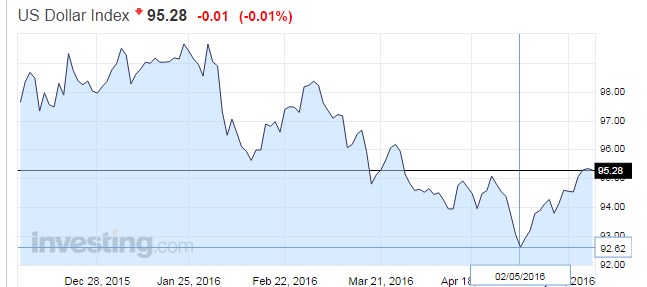The Fed
The Federal Reserve succeeded in convincing the market that a summer rate hike was more likely than it previously believed. Moreover, Dudley, who we argue, is part of the Fed’s leadership from which policy emanates, recognized risks posed by the UK referendum, and put the market on notice that although there is no scheduled press conference afterward, a move at the July meeting is also a distinct possibility.
Although the Federal Reserve has indicated that two rate hikes (rather than four that it envisaged late-December), investors have been skeptical (and more skeptical than economists). Some critics cited this as evidence of the Fed’s loss of credibility. One need not accept the Fed is a slave to the markets, as other critics claim, to appreciate that the gap between the market and the FOMC posed an operational challenge. Under such conditions, the rate hike could be more disruptive than necessary.
Last week, the Fed regained the upper hand. In the first part of the year, there was often a 100 bp spread between the FOMC’s dot plot and the Fed funds futures strip. The March dot plots in effect cut the gap in half. And now the combination of the recognition that rather than a recession, the US economy is reaccelerating, and the Federal Reserve is committed to opportunistically and gradually normalizing US monetary policy, is prodding investors to move closer to the Fed’s position.
In addition to the reassertion of the Federal Reserve’s credibility, another implication of the increased likelihood of a rate hike is that it casts doubt on the talk of a secret agreement at the Shanghai G20 meeting in late-February. The delay between the first Fed hike and the second one was not a function of some agreement among the G20 to weaken the dollar.
The delay was the result of the Fed’s assessment of domestic and global economic considerations. As those considerations changed (US economy strengthening, global markets stabilized), the Fed is preparing the markets for a resumption of hiking cycle. The heightened realization that the Fed is not “one and done” like some many have claimed may have knock-on effects on equities, emerging markets and commodities.
To the extent that risk-off dominates, it reflects renewed appreciation of the divergence meme, which is central to our bullish dollar outlook. This is an important observation because a risk-off move is typically associated with a stronger yen. Yet the yen weakened as if the increase in US rates offset the so-called safe-haven appeal of the yen.
A fortnight after the supposed secret agreement the ECB eased policy aggressively. What was discussed (or agreed upon) in Shanghai does not explain what the ECB did in March or what it is doing now. Some of the measures it announced have not been implemented yet. Even after the full program is operational, the ECB will have to monitor and evaluate the impact.
Similarly, after the BOJ surprised the world by adopting negative interest rates at the end of January, it was not G20 that prevented the BOJ from easing further. It was prudence (if such a concept is still meaningful in the context of QQE and negative rates). By the time the G20 met, the dollar had already fallen more than 7% against the yen from the late-January peak.
Bank of Japan and Failed Interventions
Surely, the Japanese did not accept the need for a weaker dollar at the Shanghai G20 meeting. Indeed, in the weeks leading up to the G7 meeting, Japanese officials wanted to secure a consensus, as they did after the 2011 earthquake and tsunami, for an official response to what it perceives as a disorderly, one-way, speculative dollar-yen market.
The media played up the difference of opinion between the US and Japan, but it seemed clear that Europe did not support Japan’s position either. To be sure, Japan can still intervene, if it wishes. Even the recent revisions to the US Treasury’s semi-annual report on the foreign exchange market does not preclude Japanese intervention. The quantitative threshold is intervention of more than 2% of GDP. Roughly speaking, this allows for nearly $100 bln of intervention.
Recall that on October 31, 2011, Japanese officials reportedly intervened and bought $100 bln against the yen in a single 24-hour period. Despite coordinated G7 intervention earlier in the year, the US dollar continued to weaken against the yen, and had fallen to new record lows near JPY75 the day of the massive intervention. Although the dollar did not return to the lows, it took more than three months, the election of Abe and the official jawboning before the dollar took out the highs it recorded on the day of the intervention.
While Japan could intervene, the bar seems high, especially ahead of the heads of state summit next weekend. Moreover, the objections raised by the US (and Europe) make the intervention a high risk venture. Unilateral intervention by Japan does not have a strong successful track record.
Failed intervention, over the objections, would be embarrassing and show weakness, when strategic ambiguity may be a better course. It could embolden the very speculators that Japanese officials argue are driving the yen higher. At the same time, it may serve to antagonize the nationalistic sentiment that Abe is nurturing to make it seem that the US is blocking Japanese intervention, even though the US has no veto.
ECB and Europe
The record from the recent ECB meeting (released last week) revealed that the officials remain concerned about the secondary impacts from the lowflation/deflation. This could take the form of weak wage growth, for example, and/or slow productivity gains.
The final April PMIs and Germany ZEW and IFO surveys will likely confirm that eurozone growth is sustaining the momentum seen in Q1 when the eurozone grew by 0.5%. Although many observers still refer to EMU growth as weak, the fact of the matter is that its growth is near trend.
The problem for the ECB is not current growth; it is the failure of many countries to enact structural reforms that would raise growth potential. That said, the ECB’s new measures did not prevent the IMF from revising its GDP forecast lower. ECB officials expect price pressures to increase as the year progresses partly as a result of the base effect and partly as a result of strengthening demand.
It is unrealistic to expect the ECB to extend its easing program until the effects of its new measures can be assessed or until it is clear that price pressures are not increasing. We suspect that the earliest ECB can reach such a conclusion is near the end of the year. Again, ECB action is perfectly understandable without having to claim a Shanghai Agreement.
Japan
Japan is in a different position. We do not think the stronger than expected Q1 GDP changes the outlook for the trajectory of policy. Preliminary estimates of Japanese GDP, like US GDP, is often subject to statistically significant revisions. It is not a solid foundation on which to build policy.
The Abe government is reportedly preparing a fiscal package, in addition to the earthquake relief measures that were approved by the Diet last week. The lack of fiscal consolidation will not deter the additional BOJ easing. Indeed, coordination of fiscal and monetary is the traditional LDP policy prescription.
Reports from the G7 meeting indicate that Finance Minister Aso informed US Treasury Secretary Lew that Japan will go ahead with the planned hike in the retail sales tax next April (from 8% to 10%). Previously there have been reports and speculation that the sales tax increase would be postponed. The impact of the sales tax increase will likely be blunted by additional fiscal measures.
Reports from the G7 meeting indicate that Finance Minister Aso informed US Treasury Secretary Lew that Japan will go ahead with the planned hike in the retail sales tax next April (from 8% to 10%). Previously there have been reports and speculation that the sales tax increase would be postponed. The impact of the sales tax increase will likely be blunted by additional fiscal measures.
Brexit
We have already seen that the UK referendum is a factor that the Fed will take into consideration at next month’s FOMC meeting. It seems reasonable that the BOJ also takes it into account when its policy meeting concludes the day after the FOMC. A July move seems more likely, though some may argue that the upper house election (July) may push the move into August.
In addition to the renewed appreciation of divergence, a couple of polls showing a swing toward the Remain camp has seen sterling extend its recent gains. Implied volatility (for one and two-month) and the premium for puts over calls pulled back in the second half of last week. Nevertheless, we caution medium-term investors from letting their guard down.
Even if the probability of Brexit is modest or low, the initial market reaction could be severe. The reason one may choose to hedge is not necessarily because one anticipates Brexit, but because one does not take the risk of ruin.
Bank of Canada meets
The only major central bank that meets in the week ahead is the Bank of Canada. Policy is on securely on hold. The rise in oil prices and the pullback of the Canadian dollar are welcomed developments. One area of concern is that the economic momentum seems fragile at the start of Q2, though the central bank will want to look through the disruption caused by the fires in Alberta.
Tags: Bank of Canada,Bank of Japan,Brexit,Dollar Index,FOMC,FX Daily,newslettersent









































